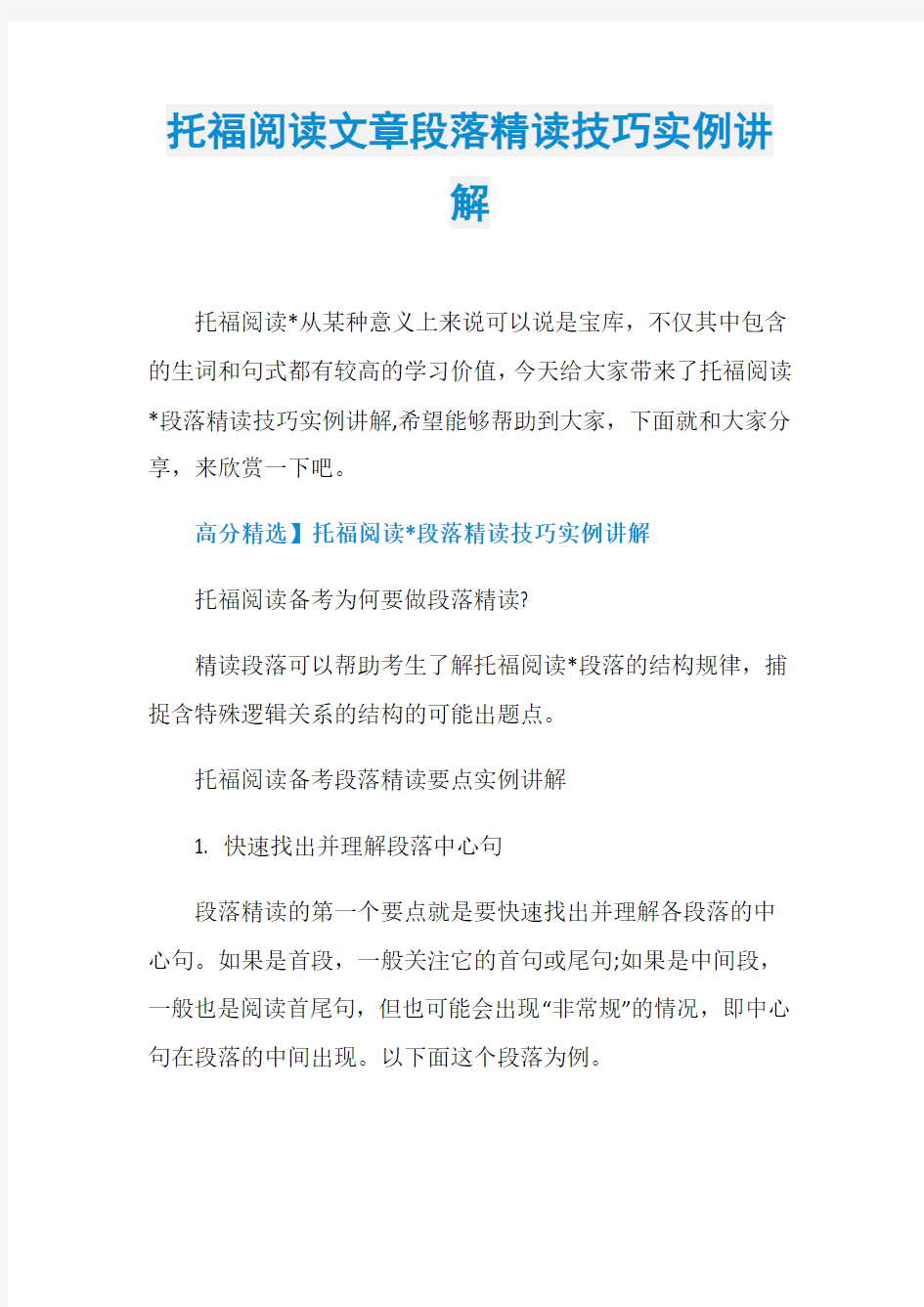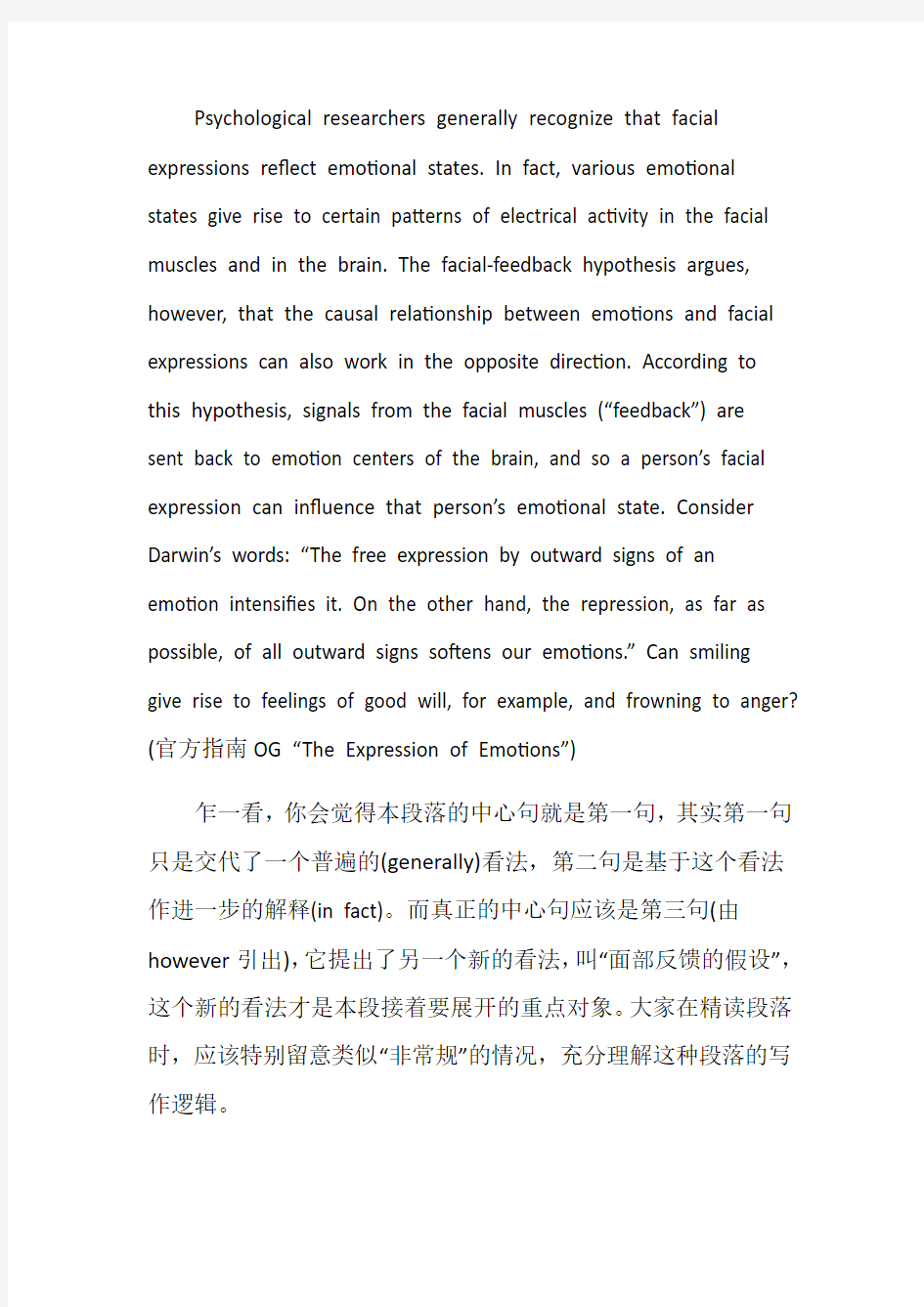

托福阅读文章段落精读技巧实例讲
解
托福阅读*从某种意义上来说可以说是宝库,不仅其中包含的生词和句式都有较高的学习价值,今天给大家带来了托福阅读*段落精读技巧实例讲解,希望能够帮助到大家,下面就和大家分享,来欣赏一下吧。
高分精选】托福阅读*段落精读技巧实例讲解
托福阅读备考为何要做段落精读?
精读段落可以帮助考生了解托福阅读*段落的结构规律,捕捉含特殊逻辑关系的结构的可能出题点。
托福阅读备考段落精读要点实例讲解
1. 快速找出并理解段落中心句
段落精读的第一个要点就是要快速找出并理解各段落的中心句。如果是首段,一般关注它的首句或尾句;如果是中间段,一般也是阅读首尾句,但也可能会出现“非常规”的情况,即中心句在段落的中间出现。以下面这个段落为例。
Psychological researchers generally recognize that facial expressions reflect emotional states. In fact, various emotional states give rise to certain patterns of electrical activity in the facial muscles and in the brain. The facial-feedback hypothesis argues, however, that the causal relationship between emotions and facial expressions can also work in the opposite direction. According to this hypoth esis, signals from the facial muscles (“feedback”) are sent back to emotion centers of the brain, and so a person’s facial expression can influence that person’s emotional state. Consider Darwin’s words: “The free expression by outward signs of an emotion intensifies it. On the other hand, the repression, as far as possible, of all outward signs softens our emotions.” Can smiling give rise to feelings of good will, for example, and frowning to anger? (官方指南OG “The Expression of Emotions”)
乍一看,你会觉得本段落的中心句就是第一句,其实第一句只是交代了一个普遍的(generally)看法,第二句是基于这个看法作进一步的解释(in fact)。而真正的中心句应该是第三句(由however引出),它提出了另一个新的看法,叫“面部反馈的假设”,这个新的看法才是本段接着要展开的重点对象。大家在精读段落时,应该特别留意类似“非常规”的情况,充分理解这种段落的写作逻辑。
2. 关注段落中逻辑关系词结构
段落精读的第二个要点就是关注段落中含逻辑关系词的结构,比如转折结构、因果结构、平行结构、连续列举结构等,这些结构往往都是托福阅读考试的出题点。笔者建议考生在精读时用记号标出这些结构的信号词,对其前后的文字加以研读,并与后面的题目进行对照,摸索阅读出题的规律。这里以“转折结构”为例作为示范。
According to conventional theory, yawning takes place when people are bored or sleepy and serves the function of increasing alertness by reversing, through deeper breathing, the drop in blood oxygen levels that are caused by the shallow breathing that accompanies lack of sleep or boredom. Unfortunately, the few scientific investigations of yawning have failed to find any connection between how often someone yawns and how much sleep they have had or how tired they are. About the closest any research has come to supporting the tiredness theory is to confirm that adults yawn more often on weekdays than at weekends, and that school children yawn more frequently in their first year at primary school than they do in kindergarten. (官方模考真题18 “The Mystery of Yawning”)
考生在精读本段落时,要特别注意本段中的Unfortunately,它是转折的信号词之一,引起了前后信息的转折,后面的句子对本段开头的传统理论(conventional theory)作出了反驳,意思是“但遗憾的是,关于打哈欠的仅有的几项科学研究并没有找到打哈欠的频率与个人睡眠时长或者疲劳程度之间的任何关联。”考生可以划出这个转折结构的句子,然后再跟后面的题目进行对照,看看是否针对这句话出题。对照之后,考生会发现有一道事实信息题与这句话有密切的关系。之后,考生还可以在脑海里再回忆下转折结构的信号词除了unfortunately还有哪些,比如还有but、however、yet、nevertheless、while、whereas等,以后读段落或做题时可以多注意这些地方。
小心托福阅读中的这些“陷阱”
陷阱一:熟词僻义
词汇类问题(Vocabulary Questions)是新托福阅读考试每次必考题型,而且题量较多,每篇*通常出现3-5题,它要求考生确定*中个别单词或短语的具体意思(一个单词可能有多个意思,但在给定选项中只有一个选项与该单词在阅读*中的意思相符)。这种题型总的来说还是比较简单的,但这种题型中的“陷阱”即“熟词僻义” 让考生们头痛不已。
所谓“熟词僻义”也就是词汇题中所考查的单词尽管考生比
较熟悉,对其常用含义也了解,但恰恰题目中考查的是该单词在
阅读*中的意思,而该意思是考生所不熟的。而往往考生们受该单词常用含义的影响,导致选错答案。比如“calling”一词的常用含义为“呼喊、召唤”,而新托福阅读中则可能考到该词的“职业、天职”的含义。
欲应对此“陷阱”,建议考生们在备考中扩大自己词汇量的同时,掌握猜测单词意思的技巧(利用上下文、构词法等),同时注意这种题型主要考查单词在*里面的意思,建议考生们在选出答案后把答案放回原文进行检验。
陷阱二:题干中设陷阱
托福阅读中,考生在浏览完一篇*之后,就可以开始答题了。我们会先阅读*题干,然后在定位原文进行答题。有些题干是有陷阱的,掉入陷阱就会出错,下面就为大家分享托福阅读题干陷阱,希望对大家有所帮助,避免陷阱,提高阅读的正确率。
最容易出错的一类题是According to the passage, which of the following is NOT true of X?和The author’s decision of X mentions all of the following EXCEPT
这类题型又叫否定事实信息题,跟事实信息题相反的是,这类题型需要选出错误的选项,并不是选择正确的选项。考生在做题过程,除了这道题目是要求选择错误选项,其它都是选择正确
的,因此考生经常在考试中犯迷糊,结果就会选错答案,影响了托福阅读的分数。
陷阱三:定位信息陷阱
托福阅读中的细节题其实不难,但前提是定位的点要对,比如下面这个例题:
Two species of deer have been prevalent in the Puget Sound area of Washington State in the Pacific Northwest of the United States. The black-tailed deer, a lowland, west-side cousin of the mule deer of eastern Washington, is now the most common. The other species, the Columbian white-tailed deer, in earlier times was common in the open prairie country, it is now restricted to the low, marshy islands and flood plains along the lower Columbia River.
According to paragraph 1, which of the following is true of the white-tailed deer of Puget Sound?
A. It is native to lowlands and marshes.
B. It is more closely related to the mule deer of eastern Washington than to other types of deer.
C. It has replaced the black-tailed deer in the open prairie.